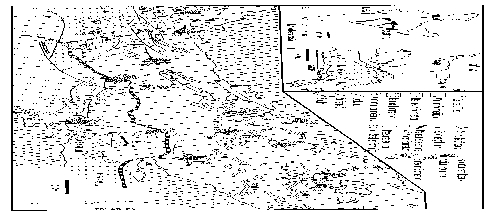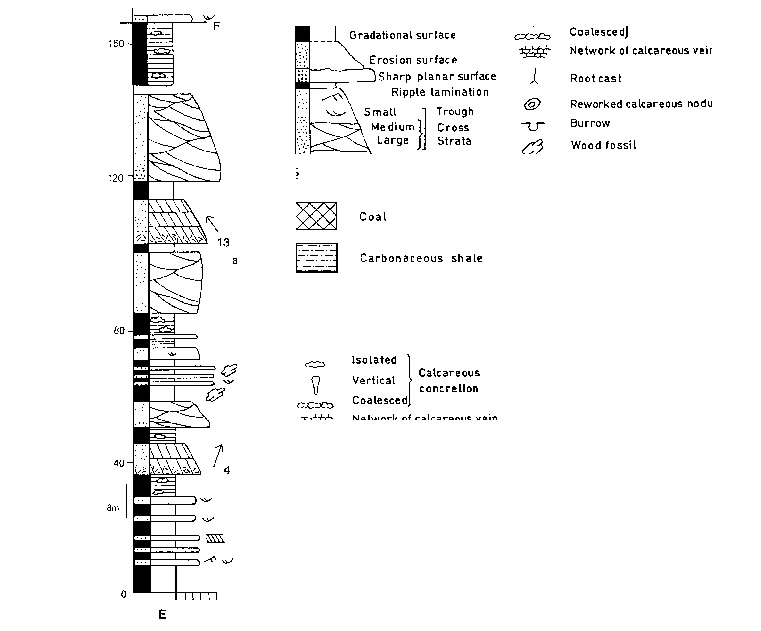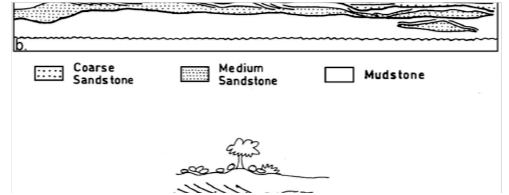Motur Fm
Type Locality and Naming
Satpura Basin: The unit was named after village Motur on the main Satpura highlands, Madhya Pradesh by Medlicott (1873). [Original Publication: Medlicott, H.B., 1873. Notes on the Satpura coal basin. Mem. Geol. Surv. Ind., 10 (1), 1-188]
Figure 1: a) Different Gondwana basins of Peninsular India (after Robinson, 1967); b) Location of Motur village; c) Geological map of the Lower Gondwana formations of Pench-Kanhan valley, Indias along with the paleocurrent directions. Location of measured stratigraphic sections of the Motur Formation are marked lines marked A, B, etc. show the position of measured sections in the Motur Formation (After Ray & Chakraborty, 2002).
Lithology and Thickness
Sandy claystone. The Motur Formation is a red mudstone-dominated succession with embedded lenses and sheets of medium- to very coarse-grained sandstone. Mudstone may be white, green or purple or dark grey in color. Sandstone to mudstone ratio varies from 1:10 to 3:1. Cross-bedding is common in the sandstone. Calcareous nodules of pedogenic origin typify red mudstone. The Motur Formation is subdivided into three facies associations as, thick sandstone association, thin sandstone association and red mudstone association (Sastry et al., 1977; Ray and Chakraborty, 2002; Sengupta et al., 2016). The thickness of the formation varies between 330–480 m.
[Figure 2: Litholog of the Motur Formatioin through the transect E on the geological map (after Ray & Chakraborty, 2002)]
[Figure 3: Field photograph of a section of the Motur Formation exposed near Pench dam (after Ray & Chakraborty, 2002)]
Relationships and Distribution
Lower contact
In Tawa valley, the Barakar Fm appears to pass gradually into the overlying Motur, but slight unconformity is noted in Pench valley. The contact with the Barakar Fm is thus sharp to gradational (Sastry et al, 1977; Ray and Chakraborty, 2002).
Upper contact
The transition of the Motur Formation to the overlying Bijori Fm is conformable and gradational.
Regional extent
Satpura Basin: Places such as Rawanwara Colliery of Pench Valley, Sukri river, Kanhan valley, with equivalents in Pranhita-Godavari Basin.
GeoJSON
Fossils
Silicified wood fossils are common that possibly belong to Dadoxylon such as D. ghorawarnense (Pareek, 1969; Sastry et al, 1977; Ray and Chakraborty, 2002). A number of leaf impressions belonging to Glossopteris indica and G. conspicua are also known (Sastry et al, 1977). Palynofossils reported are: Striatopodocarpites, Faunipoltenites, Distriatites, Verticipollenites, Striatites, Striasulcites, Crescentipottenites, Striomonosaccites, Corisaccites, Guttula-pollenites, Osmundacidites, Verrucosisporites, Barakarites, Parasaccites, Potonieisporites, Didecitriletes and Weylandites Nandi and Raha (1998); Callumispora, Cyathidites?, Cyclogranisporites, Dentatispora, Densipollenites, lbisporites, Rhizomaspora, Scheuringipollenites, Lahirites, Arcuatipollenites, Araucariacites and Ginkgocycadophytus (Srivastava and Awatar, 2002).
Age
Depositional setting
Casshyap and Qidwai (1971) inferred a fluvial-meandering depositional pattern for the Motur Formation from the evidence of higher variance of paleocurrent azimuth. However, as the paleocurrent direction measured from smaller sandstone lenses or sheets are expected to show slightly divergent direction and higher dispersion value, Ray and Chakraborty (2002) interpret anastomosing fluvial pattern based on dominance of flood basin mudstone encasing numerous crevasse sheets and fewer isolated channel sandstone bodies. Ray and Chakraborty (2002) recognized the depositional system of the Motur Formation comprising of mosaic of main channels that were intimately associated with numerous crevasse splay/levee deposits which were surrounded by extensive mud-depositing flood basin. The red coloration of the floodplain fines and calcareous soil profiles indicate a semi-arid climate with seasonal rainfall pattern during Motur sedimentation (Ray and Chakraborty, 2002).
Additional Information
References
Casshyap, S.M., Qidwai, H.A., 1971. Paleocurrent analysis of Lower Gondwana sedimentary rocks, Pench valley coalfield, Madhya Pradesh, India. Sedimentary Geology 5, 135–146. Medlicott, H.B., 1873. Notes on the Satpura coal basin. Mem. Geol. Surv. Ind., 10 (1), 1-188 Nandi, A., Raha, P.K. 1998. Palynoflora from Motur Formation, Satpura Basin, Madhya Pradesh. Indian Minerals, 52, 129-132. Pareek, 1969 Ray, S. Chakraborty, T. 2002. Lower Gondwana fluvial succession of the Pench-Kanhan valley, India: stratigraphic architecture and depositional controls. Sediment. Geol., 151, 243–271. Sastry et al, 1977 Sengupta, S., Sengupta, D.P., Bandyopadhyay, S. 2016. Stratigraphy of the Upper Gondwana Formations around Sohagpur, Western Part of the Satpura Gondwana Basin, Central India. Journal Geological Society of India, 87, 503-519. Srivastava and Awatar, 2002 Werneburg, R., Schneider, J. 1996. The Permian temnospondyle amphibians of India. In: Studies on Carboniferous and Permian vertebrates (ed.) A R Milner, Spec. Pap. Palaeont. 52 105–128.


